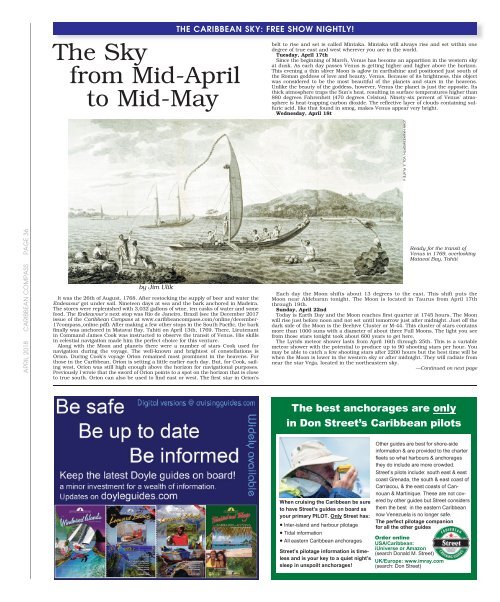Caribbean Compass Yachting Magazine - April 2018
Welcome to Caribbean Compass, the most widely-read boating publication in the Caribbean! THE MOST NEWS YOU CAN USE - feature articles on cruising destinations, regattas, environment, events...
Welcome to Caribbean Compass, the most widely-read boating publication in the Caribbean! THE MOST NEWS YOU CAN USE - feature articles on cruising destinations, regattas, environment, events...
Create successful ePaper yourself
Turn your PDF publications into a flip-book with our unique Google optimized e-Paper software.
THE CARIBBEAN SKY: FREE SHOW NIGHTLY!<br />
The Sky<br />
from Mid-<strong>April</strong><br />
to Mid-May<br />
belt to rise and set is called Mintaka. Mintaka will always rise and set within one<br />
degree of true east and west wherever you are in the world.<br />
Tuesday, <strong>April</strong> 17th<br />
Since the beginning of March, Venus has become an apparition in the western sky<br />
at dusk. As each day passes Venus is getting higher and higher above the horizon.<br />
This evening a thin sliver Moon is aglow in earthshine and positioned just south of<br />
the Roman goddess of love and beauty, Venus. Because of its brightness, this object<br />
was considered to be the most beautiful of the planets and stars in the heavens.<br />
Unlike the beauty of the goddess, however, Venus the planet is just the opposite. Its<br />
thick atmosphere traps the Sun’s heat, resulting in surface temperatures higher than<br />
880 degrees Fahrenheit (470 degrees Celsius). Ninety-six percent of Venus’ atmosphere<br />
is heat-trapping carbon dioxide. The reflective layer of clouds containing sulfuric<br />
acid, like that found in smog, makes Venus appear very bright.<br />
Wednesday, <strong>April</strong> 18t<br />
JOHN HAWKESWORTH, VOL. 2, PLATE 4<br />
APRIL <strong>2018</strong> CARIBBEAN COMPASS PAGE 36<br />
by Jim Ulik<br />
It was the 26th of August, 1768. After restocking the supply of beer and water the<br />
Endeavour got under sail. Nineteen days at sea and the bark anchored in Madeira.<br />
The stores were replenished with 3,032 gallons of wine, ten casks of water and some<br />
food. The Endeavour’s next stop was Rio de Janeiro, Brazil (see the December 2017<br />
issue of the <strong>Caribbean</strong> <strong>Compass</strong> at www.caribbeancompass.com/online/december-<br />
17compass_online.pdf). After making a few other stops in the South Pacific, the bark<br />
finally was anchored in Matavai Bay, Tahiti on <strong>April</strong> 13th, 1769. There, Lieutenant<br />
in Command James Cook was instructed to observe the transit of Venus. His skills<br />
in celestial navigation made him the perfect choice for this venture.<br />
Along with the Moon and planets there were a number of stars Cook used for<br />
navigation during the voyage. The well-known and brightest of constellations is<br />
Orion. During Cook’s voyage Orion remained most prominent in the heavens. For<br />
those in the <strong>Caribbean</strong>, Orion is setting a little earlier each day. But, for Cook, sailing<br />
west, Orion was still high enough above the horizon for navigational purposes.<br />
Previously I wrote that the sword of Orion points to a spot on the horizon that is close<br />
to true south. Orion can also be used to find east or west. The first star in Orion’s<br />
Ready for the transit of<br />
Venus in 1769, overlooking<br />
Matavai Bay, Tahiti<br />
Each day the Moon shifts about 13 degrees to the east. This shift puts the<br />
Moon near Aldebaran tonight. The Moon is located in Taurus from <strong>April</strong> 17th<br />
through 19th.<br />
Sunday, <strong>April</strong> 22nd<br />
Today is Earth Day and the Moon reaches first quarter at 1745 hours. The Moon<br />
will rise just before noon and not set until tomorrow just after midnight. Just off the<br />
dark side of the Moon is the Beehive Cluster or M-44. This cluster of stars contains<br />
more than 1000 suns with a diameter of about three Full Moons. The light you see<br />
from those stars tonight took about 600 years to get here.<br />
The Lyrids meteor shower lasts from <strong>April</strong> 16th through 25th. This is a variable<br />
meteor shower with the potential to produce up to 90 shooting stars per hour. You<br />
may be able to catch a few shooting stars after 2200 hours but the best time will be<br />
when the Moon is lower in the western sky or after midnight. They will radiate from<br />
near the star Vega, located in the northeastern sky.<br />
—Continued on next page<br />
The best anchorages are only<br />
in Don Street’s <strong>Caribbean</strong> pilots<br />
When cruising the <strong>Caribbean</strong> be sure<br />
to have Street’s guides on board as<br />
your primary PILOT. Only Street has:<br />
Inter-island and harbour pilotage<br />
Tidal information<br />
All eastern <strong>Caribbean</strong> anchorages<br />
Street’s pilotage information is timeless<br />
and is your key to a quiet night’s<br />
sleep in unspoilt anchorages!<br />
Other guides are best for shore-side<br />
information & are provided to the charter<br />
fleets so what harbours & anchorages<br />
they do include are more crowded.<br />
Street’s pilots include: south east & east<br />
coast Grenada, the south & east coast of<br />
Carriacou, & the east coasts of Cannouan<br />
& Martinique. These are not covered<br />
by other guides but Street considers<br />
them the best in the eastern <strong>Caribbean</strong><br />
now Venezuela is no longer safe.<br />
The perfect pilotage companion<br />
for all the other guides<br />
Order online<br />
USA/<strong>Caribbean</strong>:<br />
iUniverse or Amazon<br />
(search Donald M. Street)<br />
UK/Europe: www.imray.com<br />
(search: Don Street)


















